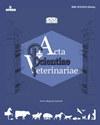Effect of Ovarian Status on Reproductive Performance in Dairy Heifers Inseminated with Sexed Semen
IF 0.2
4区 农林科学
Q4 VETERINARY SCIENCES
引用次数: 1
Abstract
Background: The intensive reproductive management in the dairy farms requires inclusion of a large group of replacement heifers in the breeding program for a shorter period. In this aspect, a creation of effective estrus synchronization protocols with timed artificial insemination (TAI) by sexed semen and optimization of the current ones have a crucial role for obtaining high pregnancy rate. These protocols are beneficial, because they led to reduced interval to first AI, lack of need for estrus detection, and allow obtaining a large group of female calves for on time. Because of limited fertilizing potential of sexed spermatozoa this type of semen is applied mainly for heifers, as fertility is higher compared to lactating cows. The main objective of the present study was to investigate the effect of ovarian status on the reproductive performance in dairy heifers subjected to estrus synchronization and timed artificial insemination with sexed semen. Materials, Methods & Results: Forty-eight Holstein healthy heifers separated in 2 groups were subjected to PGF2α-GnRH pre-treatment and Ovsynch or PRID-5-day estrus synchronization protocol and timed artificial insemination (TAI) with sex-sorted semen, staring 6 days after end of the hormonal pre-treatment. The ovarian status (presence of follicles with or not a corpus luteum) of the heifers at the begin of the treatment, on day of TAI and pregnancy rate in different groups were determined and compared. Additionally, the ovarian status at the begin of the treatment, ovarian status and size of preovulatory follicle (PF) on day of TAI and total values for both groups according to reproductive performance (pregnant or non-pregnant) were also analyzed. On day of TAI the animals with PF and a lack of corpus luteum (CL) in both groups were more that those with PF and CL (39.3% and 30% vs. 60.7 % and 70%), with significant (P < 0.05) difference in PRID-5-day group. The pregnancy rate tended to be higher in PRID-5 day than Ovsynch treatment (65% vs. 35.7%). A higher percentage (100% and 67.9%) of the pregnant animals in both treatments had not CL on day of TAI, and the size of the PF (1.58 ± 0.12 cm and 1.64 ± 0.13 cm) was increased (P < 0.05). Similar effects of the ovarian status on reproductive performance were obtained after a comparison of the total values between pregnant and non-pregnant animals. The percentage of heifers with observed PF without CL on day of TAI was significantly greater (P < 0.05) in pregnant compared to non-pregnant group (91.3% vs. 40%). The opposite dependence was determined for the parameter presence of follicles and corpus luteum (8.7% vs. 60%; P < 0.05). Furthermore, the size of the PF measured immediately before TAI was increased in animals became pregnant (1.60 ± 0.12 cm vs. 1.34 ± 0.17 cm; P < 0.05). Discussion: The analysis of the obtained results showed that the ovarian status on day of TAI affects the reproductive performance in dairy heifers subjected to estrus synchronization and timed artificial insemination with sexed semen. Hormonal pre-treatment with onset of PRID-5-day protocol 6 days later and TAI with sex-sorted semen ensure acceptable pregnancy rate. The greater preovulatory follicle and a lack of corpus luteum before insemination provide significantly (P < 0.05) more pregnant animals, compared to the cases when CL is presented. Ultrasound determination of the ovarian function before insemination can be used in selection of heifers for TAI with sex-sorted semen. Keywords: heifers; estrus synchronization; sexed semen, pregnancy.卵巢状态对性精受精奶牛生殖性能的影响
背景:奶牛场的集约化生殖管理需要在较短的时间内将一大批替代小母牛纳入育种计划。因此,建立有效的有性精子定时人工授精(TAI)同步发情方案并对现有方案进行优化,对获得高妊娠率具有重要意义。这些协议是有益的,因为它们减少了第一次人工智能的间隔,不需要发情检测,并允许按时获得一大群雌性小牛。由于有性精子的受精潜力有限,这种类型的精液主要用于母牛,因为母牛的受精率比泌乳母牛高。本研究的主要目的是研究卵巢状态对同步发情和定时人工授精的奶牛生殖性能的影响。材料、方法与结果:选取48头健康的荷斯坦小母牛,分为两组,在激素预处理结束后6 d开始进行PGF2α-GnRH预处理和排卵同步或prid -5 d发情同步方案,并使用按性别分类的精液定时人工授精(TAI)。测定并比较各组犊牛在给药前、给药当天卵巢状态(有无黄体卵泡)及妊娠率。分析治疗开始时卵巢状态、TAI当天卵巢状态及排卵前卵泡大小(PF),以及两组根据生殖表现(怀孕或未怀孕)的总价值。在TAI第1天,两组中出现PF和黄体缺失(CL)的动物多于出现PF和CL的动物(39.3%和30% vs. 60.7%和70%),其中prid -5 d组差异有统计学意义(P < 0.05)。prd -5天妊娠率高于Ovsynch组(65% vs. 35.7%)。两组大鼠妊娠第1天未发生CL的比例(100%和67.9%)均高于对照组(P < 0.05), PF的大小(1.58±0.12 cm和1.64±0.13 cm)均高于对照组(P < 0.05)。在对怀孕和未怀孕动物的总价值进行比较后,得出了卵巢状态对生殖性能的类似影响。妊娠第1天无CL的PF犊牛比例显著高于未妊娠组(91.3%比40%)(P < 0.05)。卵泡和黄体存在的依赖性相反(8.7% vs. 60%;P < 0.05)。此外,妊娠动物在TAI前测量的PF尺寸增加(1.60±0.12 cm vs. 1.34±0.17 cm;P < 0.05)。讨论:对所得结果的分析表明,同步发情和定时人工授精对乳母牛的生殖性能有影响。激素前治疗(prd -5天方案6天后)和TAI(精液性别分类)确保可接受的妊娠率。与出现CL的病例相比,排卵前卵泡较大和授精前黄体缺失显著(P < 0.05)增加了怀孕动物的数量。人工授精前卵巢功能的超声检测可用于选择具有性别分类精液的TAI母牛。关键词:小牝牛;发情同步;性精液,怀孕。
本文章由计算机程序翻译,如有差异,请以英文原文为准。
求助全文
约1分钟内获得全文
求助全文
来源期刊

Acta Scientiae Veterinariae
VETERINARY SCIENCES-
CiteScore
0.40
自引率
0.00%
发文量
75
审稿时长
6-12 weeks
期刊介绍:
ASV is concerned with papers dealing with all aspects of disease prevention, clinical and internal medicine, pathology, surgery, epidemiology, immunology, diagnostic and therapeutic procedures, in addition to fundamental research in physiology, biochemistry, immunochemistry, genetics, cell and molecular biology applied to the veterinary field and as an interface with public health.
The submission of a manuscript implies that the same work has not been published and is not under consideration for publication elsewhere. The manuscripts should be first submitted online to the Editor. There are no page charges, only a submission fee.
 求助内容:
求助内容: 应助结果提醒方式:
应助结果提醒方式:


